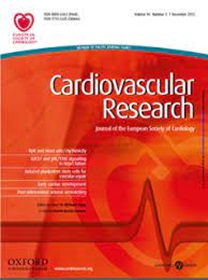脑干C1神经元介导急性盐负荷时心衰失代偿和死亡
IF 10.2
1区 医学
Q1 CARDIAC & CARDIOVASCULAR SYSTEMS
引用次数: 0
摘要
心衰(HF)是一种新兴的世界性流行病。尽管治疗取得了进展,但心衰的发病率和死亡率仍然很高,全球患病率继续上升。心衰的常见临床特征包括心脏交感神经兴奋、呼吸障碍和肾功能障碍;肾功能不全会导致钠潴留和体液超载,导致心衰患者预后不良。我们之前已经证明,脑干前交感神经元(C1)来自吻侧腹外侧髓质(RVLM)在HF实验模型的交感调节中起关键作用。然而,在HF的情况下,RVLM-C1神经元在盐负荷中的作用尚不清楚。本研究检验RVLM C1神经元是否驱动心衰大鼠的心肺失代偿,最终导致猝死。方法与结果采用动-静脉分流法,保留射血分数(HFpEF)诱导成年雄性sd大鼠HF。HFpEF诱导2周后,采用抗多巴胺β-羟化酶皂苷毒素(DβH-SAP)对RVLM C1神经元进行双侧选择性消融。然后连续3周饲喂高钠+日粮(食物中含3% Na+,水中含2% Na+),诱导代偿到失代偿的HF状态转变。超声心动图、心脏自主神经功能、呼吸功能和生存在HF进展期间进行评估。盐负荷导致HF大鼠明显失代偿,死亡风险显著增加(死亡率:100% vs. 10% HFpEF+Na+ vs. HFpEF)。此外,与HF相比,HFpEF+Na+动物表现出心脏交感驱动进一步增加和更严重的呼吸障碍,包括更高的缺氧相关时间(即呼吸暂停/呼吸不足)。消融RVLM C1神经元部分减少HF患者盐负荷时过度的心脏交感神经兴奋,改善HFpEF+Na+大鼠过度的呼吸紊乱,降低失代偿相关死亡率。我们发现缺氧,而不是高钠,是分离成人心肌细胞钙处理受损的主要原因。结论我们的研究结果强烈提示,RVLM C1神经元在盐负荷期间参与急性HF失代偿,其机制包括交感神经外流和缺氧相关呼吸障碍的进一步增加。这一机制可能最终通过心肌细胞钙处理不当影响心脏收缩力,增加发病率和死亡率。本文章由计算机程序翻译,如有差异,请以英文原文为准。
Brainstem C1 neurons mediate heart failure decompensation and mortality during acute salt loading
Aims Heart failure (HF) is an emerging epidemic worldwide. Despite advances in treatment, the morbidity and mortality rate of HF remain high, and the global prevalence continues to rise. Common clinical features of HF include cardiac sympathoexcitation, disordered breathing, and kidney dysfunction; kidney dysfunction strongly contributes to sodium retention and fluid overload, leading to poor outcomes of HF patients. We have previously shown that brainstem pre-sympathetic neurons (C1) from the rostral ventrolateral medulla (RVLM) play a key role in sympathetic regulation in experimental models of HF. However, the role of RVLM-C1 neurons during salt-loading in the context of HF is unknown. This study tests whether RVLM C1 neurons drive cardiorespiratory decompensation, and ultimately lead to sudden death in HF rats. Methods and Results Adult male Sprague-Dawley rats underwent arterio-venous shunt to induce HF with preserved ejection fraction (HFpEF). Two-weeks after HFpEF induction, bilateral selective ablation of RVLM C1 neurons was performed using anti-dopamine β-hydroxylase-saporin toxin (DβH-SAP). Animals were then fed a high Na+ diet (3% Na+ in food and 2% Na+ in water) for 3 weeks to induce compensated-to-decompensated HF state transition. Echocardiography, cardiac autonomic function, breathing function, and survival were assessed during the progression of HF. Salt loading resulted in marked decompensation in HF rats, as evidenced by a significant increase in mortality risk (mortality: 100% vs. 10% HFpEF+Na+ vs. HFpEF). Furthermore, HFpEF+Na+ animals showed a further increase in cardiac sympathetic drive and more severe disordered breathing, including higher hypoxia-related epochs (i.e. apneas/hypopneas), compared to HF. Ablation of RVLM C1 neurons partly reduced the excessive cardiac sympathoexcitation during salt loading in HF, improved the exaggerated disordered breathing in HFpEF+Na+ rats, and reduced decompensation-linked mortality. We found that hypoxia, but not high sodium, was the major contributor to impaired calcium handling in isolated adult cardiomyocytes. Conclusion Our results strongly suggest that RVLM C1 neurons contribute to acute HF decompensation during salt loading by a mechanism encompassing further increases in sympathetic outflow and hypoxia-related breathing disorders. This mechanism may ultimately impact cardiac contractility through cardiomyocyte calcium mishandling, increasing morbidity and mortality.
求助全文
通过发布文献求助,成功后即可免费获取论文全文。
去求助
来源期刊

Cardiovascular Research
医学-心血管系统
CiteScore
21.50
自引率
3.70%
发文量
547
审稿时长
1 months
期刊介绍:
Cardiovascular Research
Journal Overview:
International journal of the European Society of Cardiology
Focuses on basic and translational research in cardiology and cardiovascular biology
Aims to enhance insight into cardiovascular disease mechanisms and innovation prospects
Submission Criteria:
Welcomes papers covering molecular, sub-cellular, cellular, organ, and organism levels
Accepts clinical proof-of-concept and translational studies
Manuscripts expected to provide significant contribution to cardiovascular biology and diseases
 求助内容:
求助内容: 应助结果提醒方式:
应助结果提醒方式:


